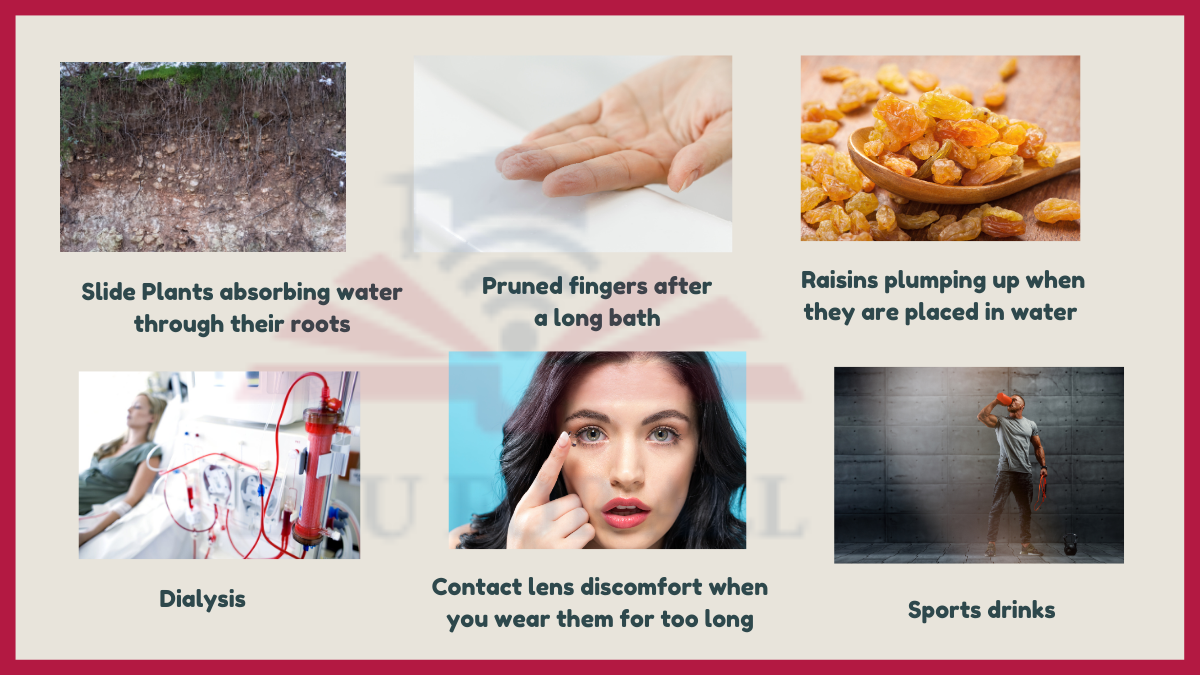Plants absorb water through their roots, pickles shrivel in freshwater, raisins plump up in the water, fingers prune in long baths, contact lenses cause discomfort after prolonged use, IV fluids rehydrate patients, dialysis cleanses blood, food preservation methods remove water, contact lens solutions maintain hydration, and sports drinks replenish electrolytes lost through sweat.

- Examples of Osmosis
- 1. Plants absorbing water through their roots
- 2. Pickles shriveling when they are placed in freshwater
- 3. Raisins plumping up when they are placed in water
- 4. Pruned fingers after a long bath
- 5. Contact lens discomfort when you wear them for too long
- 6. IV fluids
- 7. Dialysis
- 8. Food preservation
- 9. Contact lens solution
- 10. Sports drinks
Examples of Osmosis
Here are some common Examples of Osmosis:
1. Plants absorbing water through their roots
Plants absorb water from the soil through their roots through osmosis. The water concentration in the soil is higher than the water concentration inside the root cells, so the water moves into the root cells by osmosis.
2. Pickles shriveling when they are placed in freshwater
Pickles are placed in a brine solution, which is a salt solution, to preserve them. The salt concentration in the brine solution is higher than the water concentration inside the pickle cells. When the pickles are placed in fresh water, the water concentration in the freshwater is higher than the water concentration inside the pickle cells, so the water moves into the pickle cells by osmosis. This causes the pickles to swell.
3. Raisins plumping up when they are placed in water
Raisins are dried grapes. When raisins are placed in water, the water concentration in the water is higher than the water concentration inside the raisin cells. So, the water moves into the raisin cells by osmosis, causing them to plump up.
4. Pruned fingers after a long bath
When you take a long bath, your fingers become pruned because the water concentration in the bath water is higher than the water concentration inside your skin cells. So, the water moves into your skin cells by osmosis, causing them to swell.
5. Contact lens discomfort when you wear them for too long
Contact lenses are made of a material that allows water to pass through it. When you wear contact lenses for too long, the water concentration in your tears is higher than the water concentration inside the contact lenses. So, the water moves into the contact lenses by osmosis, causing them to swell. This can cause discomfort and irritation.
6. IV fluids
Intravenous (IV) fluids are delivered directly into the bloodstream. IV fluids are used to rehydrate patients who are dehydrated or to deliver medications. IV fluids are typically made of saline solution, which is a salt solution. The salt concentration in the saline solution is higher than the water concentration inside the blood cells. So, the water moves into the blood cells by osmosis, causing them to swell. This helps to rehydrate the patient and deliver the medications to the tissues.
7. Dialysis
Dialysis is a medical procedure that is used to clean the blood of patients with kidney failure. During dialysis, the patient’s blood is passed through a dialyzer, which is a semipermeable membrane. The dialyzer allows waste products to move out of the blood and clean water to move into the blood. This process occurs through osmosis.
8. Food preservation
Food can be preserved by using osmosis to remove water from the food. This can be done by placing the food in a salt solution or by drying the food. When the food is placed in a salt solution, the salt concentration in the solution is higher than the water concentration inside the food cells. So, the water moves out of the food cells by osmosis, which helps to preserve the food.
9. Contact lens solution
Contact lens solution is used to clean and store contact lenses. Contact lens solution contains a variety of ingredients, including saline solution and detergents. The saline solution helps to keep the contact lenses hydrated and the detergents help to clean them. The saline solution in the contact lens solution is hypertonic, which means that it has a higher salt concentration than the water inside the contact lenses. This helps to prevent the contact lenses from drying out.
10. Sports drinks
Sports drinks are designed to rehydrate athletes and replace the electrolytes that they lose through sweat. Sports drinks typically contain a mixture of water, electrolytes, and carbohydrates. The electrolytes in the sports drink help to draw water into the body’s cells. This helps to rehydrate the athlete and improve their performance.

